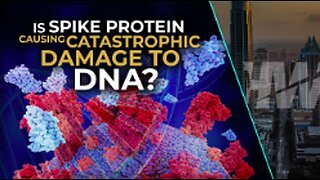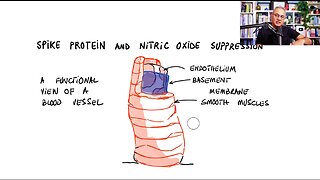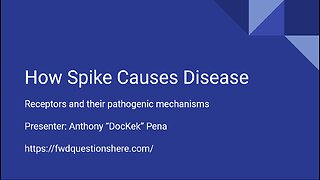Spike Protein Goes to Nucleus and Impairs DNA Repair (In-Vitro Study)
https://www.youtube.com/watch?v=-SYL-iU0E9Q&t=1349s
Spike Protein and DNA Repair Impairment
The study found that the SARS-CoV-2 spike protein could bind to and inhibit the activity of two DNA repair proteins: DNA polymerase β and APE1. DNA polymerase β is responsible for repairing single-strand breaks in DNA, while APE1 is responsible for repairing double-strand breaks in DNA.
The researchers also found that the SARS-CoV-2 spike protein could inhibit the activity of a protein called V(D)J recombinase. V(D)J recombinase is a protein that is essential for the process of V(D)J recombination, which is how B cells and T cells generate their diverse repertoire of receptors.
🧬 The spike protein of the virus can enter the nucleus and impair DNA repair, potentially leading to significant side effects.
🧬 Spike protein impairs DNA repair, potentially leading to genetic damage and instability.
🌡️ According to researchers, preventing this impairment may involve using smaller subunits of the spike protein in vaccines, such as the RBD or other parts of the virus.
🧪 The presence of certain repair enzymes, such as BRCA1 and 53BP1, is crucial for fixing DNA breaks caused by the virus.
🦠 "When SARS-CoV-2 infects a cell, it impairs DNA repair and can potentially cause more harm."
Complexity of Viral Replication and DNA Repair
🦠 The process of virus replication involves the production of various proteins, which are then assembled and packaged before the virus is released from the cell, highlighting the complexity of viral replication within the host.
🧬 "If there are DNA breaks during the cell cycle, there are strict mechanisms to ensure correct repair and prevent the formation of cancer cells."
🧪 Different phases of the cell cycle require different DNA repair mechanisms, highlighting the complexity of the repair process.
🌡️ Proliferation of cells, caused by infection, can result in an increased number of cells and potential DNA damage, highlighting the importance of the immune system response.
🧪 In-vitro studies suggest that the messenger RNA for producing DNA repair enzymes is transcribed in the nucleus and then sent outside for translation, highlighting the complex communication between the nucleus and cytoplasm in cellular processes.
-
 12:17
12:17
Altered Genome
1 year agoSpike protein Impairs DNA Damage Repair
82 -
 1:09
1:09
Biological Medicine
1 year agoSpike Proteins may cause cancer by inhibiting DNA repair
99 -
 2:06:53
2:06:53
Healthcare Topics from "COVID NURSE"
7 months agoSpike protein in many organs ~The Effects of the Spike Protein " The Cell, DNA, & Immunity " P2"
3202 -
 8:52
8:52
Biological Medicine
1 year agoSpike protein mRNA in COVID vaccines alters human DNA within hours after injection
6381 -
 30:28
30:28
Right2Freedom
1 year agoSpike Proteins Disrupt Nitric Oxide
3242 -
 59:49
59:49
All Bleeding Eventually Stops
1 year agoHealing the Damage from Spike Proteins
191 -
 1:45
1:45
RedpillUSAPatriots
1 year agoDr. Steven Hatfill on the Devastating Effects of mRNA Produced Spike Protein
8003 -
 10:56
10:56
Right2Freedom
11 months agomRNA Shedding: Spike Protein Causes MASSIVE Inflammation Increase In Human Body
2701 -
 50:43
50:43
Sunfellow On COVID-19
2 years agoDrBeen: Spike Genes Have Patented DNA Sequences. This Is Dangerous.
13.2K14 -
 2:36:09
2:36:09
DocKek
1 year agoHow Spike Causes Disease
4364